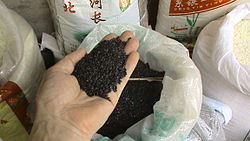Chakhao
Chakhao or Chak Hao (Manipuri black aromatic rice) is a species of paddy plant. It grows in the plains of Manipur, India.[1][2][3] It has two subspecies, "Chakhao poireiton" and "Chakhao amubi".[4] Chak hao rice, also known as black rice, stands out with its dark purple color and delicious nutty taste. Not only is chak hao rice packed with antioxidants, vitamins, and minerals, but it is also highly valued for its cultural and culinary significance in the region.
| Chak-Hao | |
|---|---|

| |
| "Chak-Hao" paddy seeds | |
| Scientific classification | |
| Kingdom: | |
| Division: | |
| Class: | |
| Order: | |
| Family: | |
| Genus: | Oryza
|
Health benefits of chak hao rice
Chak hao rice is a powerhouse of essential nutrients like protein, fiber, iron, and vitamin E. It's also loaded with anthocyanins, powerful antioxidants that give it its deep purple color. With its impressive nutritional profile, Chak Hao rice is a fantastic addition to any healthy diet.
Thanks to its high anthocyanin content, chak hao rice has antioxidant properties. These antioxidants help fight off free radicals, reducing oxidative stress and lowering the risk of chronic diseases such as cancer and diabetes. Plus, its anti-inflammatory properties contribute to overall health and well-being.
Chak hao can help manage weight, thanks to its fiber content that keeps people feeling full and satisfied. The fiber also aids in digestion and helps regulate blood sugar levels. It can also help keep the heart healthy - the antioxidants and essential nutrients in chak hao rice can help lower bad cholesterol levels and improve cardiovascular function, making it a heart-friendly food option.[5]
Gallery
Chakhao Media
Balatinaw (or Balatinao), an heirloom black rice from Mountain Province, Philippines
Black rice as sold in China
Bibliography
- Asem, Ibemhal Devi (2017). The Deep Purple Color and the Scent are Two Great Qualities of the Black Scented Rice (Chakhao) of Manipur. IntechOpen.
References
- ↑ Li, Jin Quan (2017-03-15). Advances in International Rice Research. BoD – Books on Demand. ISBN 978-953-51-3009-3.
- ↑ Fauna of Manipur: Vertebrates and animal fossils. Zoological Survey of India. 2004. ISBN 978-81-8171-043-7.
- ↑ Singh, E. Ishwarjit (2005). Manipur, a Tourist Paradise. B.R. Publishing Corporation. ISBN 978-81-7646-506-9.
- ↑ "Manipur Black rice Chak-Hao gets GI tag". Archived from the original on 2021-04-19. Retrieved 2021-04-19.
- ↑ "What is Chak Hao Rice? Discover the Nutritional Powerhouse from Manipur". GlobalFushion. Retrieved 2024-06-14.[dead link]




